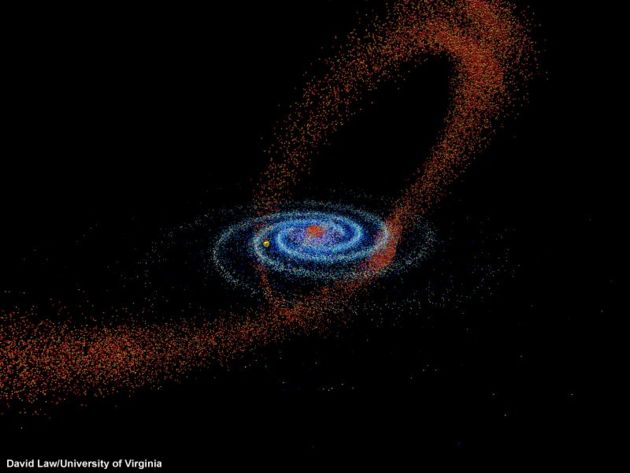| Tweet |

私達の住んでいる太陽系(黄色)は、現在、向かって左側のらせん状・Sagittarius dwarf galaxy(小射手座系?)と 右側のらせん状・Milky Way galaxy(銀河系)との間の位置にいる。太陽系の磁場の関係で他の銀河系の軌道から60-90度の角度で外れていっている。
ーーーーーーーーーーーーーーーーーーーーーーーーーーーーーーーーーーーーーーーーーー
少し古いが七夕ということで、2007年6月5日付け、「ABC オーストラリア」より、我々の太陽系が他の銀河系集団の軌道から外れた位置にいるというニュース。
http://abc.net.au/science/news/stories/2007/1942665.htm
Solar system and Milky Way doing the splits
Irene Klotz
Discovery News
Tuesday, 5 June 2007
Our solar system is travelling in a different direction to the rest of the Milky Way, scientists say.
When they used radio signals from two spacecraft nearing interstellar space to map the route, they had some unexpected results.
The researchers determined that the magnetic field in interstellar space is propelling our solar system along at a 60-90° angle to the rest of the galaxy.
That's happening because the part of the interstellar magnetic field that comes closest to our system is not parallel to the spiraling arms of the galaxy, as it appears to be elsewhere.
As a result, our solar system has taken on a bullet-shaped appearance as it soars through space, says Dr Merav Opher, an assistant professor from George Mason University in Virginia, who publishes the research in the journal Science.
The researchers used data from the two 30-year-old Voyager probes and computer modelling to calculate the solar system's position.
To measure our solar system, scientists study the places where the Sun's influence ends and interstellar space begins, an area known as the heliosphere.
The Sun's domain is flecked with ionised particles called the solar wind, which surrounds the system like a bubble. Beyond the bubble is interstellar space, which contains mostly hydrogen and helium.
Researchers modelled the area where the heliosphere runs into the interstellar magnetic field and beyond to find the odd angle.
Studying the interaction between the heliosphere and interstellar space yields insights into phenomena that can affect Earth, such as galactic cosmic rays, points out Professor Randy Jokipii, with the University of Arizona in Tucson, in a related paper in Science.
Voyager 1 has passed through the outer bubble of solar wind is now exploring a transition region known as the heliosheath. Voyager 2 has yet to pass through the solar wind termination zone.
Additional studies are planned using both probes as well as the Solar and Heliospheric Observatory, and a new spacecraft called the Interstellar Boundary Explorer, is scheduled to launch next year.
http://www.space.com/scienceastronomy/galaxy_gobble_030924.html
Detailed Look at Milky Way Gobbling a Galaxy
By Robert Roy Britt
Senior Science Writer
posted: 02:45 pm ET
24 September 2003
Detailed new observations of our Milky Way Galaxy reveal thousands of stars being stripped from a neighbor that's stretched into a twisted shape resembling a wet noodle.
The Sagittarius dwarf galaxy, now a vestige of its former self, serves as a snack for the much larger Milky Way.
Astronomers already knew Sagittarius was being torn apart. The new study maps the extent of the carnage, showing how debris wraps around and passes through the Milky Way, astronomers said today.
Sagittarius is 10,000 times less massive than the Milky Way.
"It's clear who's the bully in the interaction," said Steven Majewski, a University of Virginia professor of astronomy.
太陽系は実は元々銀河系に所属するものではなかったという説も下記に書かれているが、これは現在の段階では”進んだ”話なので、参考としてURLを。
http://curezone.com/blogs/m.asp?f=1207&i=2
▲このページのTOPへ HOME > 環境・エネルギー・天文板2掲示板
フォローアップ:- Re: 太陽系は銀河系の軌道から60-90度の角度で外れていっている(ABC オーストラリア) REPU 2007/7/09 13:29:55
(0)
投稿コメント全ログ コメント即時配信 スレ建て依頼 削除コメント確認方法
 題名には必ず「阿修羅さんへ」と記述してください。
題名には必ず「阿修羅さんへ」と記述してください。
掲示板,MLを含むこのサイトすべての
一切の引用、転載、リンクを許可いたします。確認メールは不要です。
引用元リンクを表示してください。